What types of foundations should I consider?
As with any structure, it is essential to provide a firm, level and square base; without which, your building will become unstable and will deteriorate rapidly. If you plan your project properly and take the time to do it right, it will last for many years.
|
Concrete Slab - The best method - provided it's done well. A job for a competent Do-it-Yourselfer, or a professional builder. |
|
Pier and Beam - Simple, yet effective. A good solution if the building may need to be moved in future years. |
|
Treated Wood Runners - An easy non-permanent solution. You simply clear the site, level off the area and begin. Using treated wood is a must for this option. |
Whichever method you use, it is important that the end result is above all, firm, level and square. If you are constructing the base for a building over 12' x 8', a garage, a sectional building, a corner unit, a gazebo, or a building with no floor, then the more permanent poured concrete slab might be best.
It isn't within the scope of this material to try and detail each and every foundation option. What we have chosen to do is outline the intermediate type foundation and provide some ideas and information that might be useful no matter which type of base you choose for your project.
The Pier and Beam Foundation- 8x8 Shed
We will outline the most common type of shed foundation, the pier and beam type.
We will use 4x4s lumber as skids or beams, with three concrete pads, spaced along the length of each cross member. This means that the concrete pads will be four feet apart side to side and front to back. The first procedure involves laying and levelling nine 1' x 1' concrete paving stones as support for the 4x4 beams. You don't need the most expensive blocks available. What is important is the compression strength, not beauty as these blocks will be hidden by the rest of the construction. (see the diagram below for layout details)
1. Carefully level the ground (keeping a slight grade so any water getting under the shed will drain away). Remove any grass or groundcover.
2. Next lie down and tamp in a layer of crushed stone or rock to aid in drainage. This will be a solid base for your project.
3. Lay out your foundation outline by using string and stakes, allowing about 6" excess from each of your measurements for the some overhang of the foundation blocks. 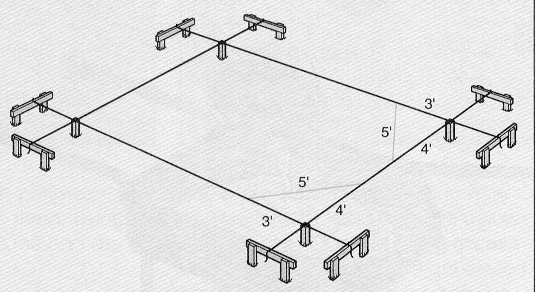
The batter boards, H-shaped stakes made from scrap lumber, are outside the actual corner lines and allow for adjustments that define the square corners.
How to square a rectangular foundation.
Remember the Pythagorean Theory from High School? Well, now is the time to use it. Some building texts call it the 3-4-5 rules. In any case it serves well here. As applied here, it will help in laying your foundation out squarely. Begin by using your tape measure to mark some guide points to work with. Mark the string corner at a 3' mark on one side, 4' on another side and "checking" the right angle by adjusting the diagonal distance to the 3' and 4' marks by adjusting the angle.
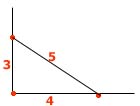
The goal is to bring the angle between the two marked sides to a perfect 90 degrees such that it measures exactly 5' when measured across the diagonal.
Alternative method for squaring a foundation.
An alternative squaring method when laying out a square foundation is to simply layout your string lines or blocks and adjust by measuring the diagonal, corner to corner.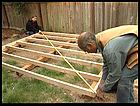
When squared the diagonal corner measurements will be equal.
5. To level the blocks, lay them down inside the string perimeter. By using either of the methods outlined above you can square their position properly. 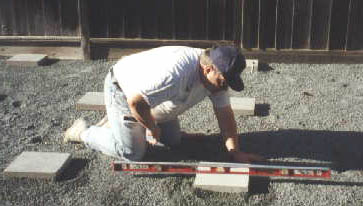
6. Now let's determine that each pad is sitting level. Place the four-foot level on each block, first east-west, then north-south and adjusting the fill under each block to ensure it is level.
7. Next, use the level to determine which of the nine pads was the lowest. Designate this one the "king pad." Now level the two adjacent perimeter pads in reference to the "king" pad. Remove a little crushed stone or dirt from under each pad until it is level with the king pad. This can take some time as you have to lift up the pad, remove some crushed stone, put the pad back and tap it solid, then re-measure the level and, if necessary, do it all again.
8. From here level each successive pad around the perimeter. Go both directions around the perimeter until you get to the pad diagonally across from the king pad. Level this last block from one side and check its level from the other side.
9. Finally, level the middle pad from one side and, as a final check of the entire process, checked the level of the middle pad from the other three sides. This procedure if carefully done should give you a very level base.
10. Here are some tips that will help you with the slab or concrete foundation. The principals remain the same for layout and squaring the forms that will be required to pour the concrete into.
Inside the batter board and string outline the soil will have to be removed so that the concrete can be poured to a prescribed depth for your local codes and conditions. 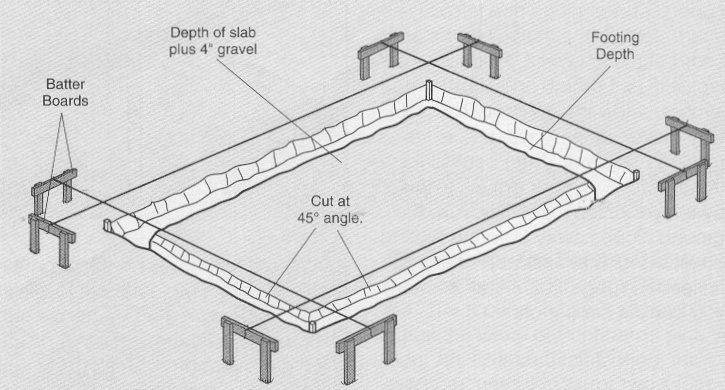
Your local building supply store can provide information concerning materials required for a given slab dimensions. Many of the larger warehouse operations offer clinics and free handout materials that can help you get started on pouring your own concrete foundation.
Now you have a solid foundation on which to lie out your floor joists and flooring. Let's take a look at the Plans.
Wyszukiwarka
Podobne podstrony:
Types of syllabuses
Posterior Capsular Contracture of the Shoulder
Types of regimes in Plato s thought
Part12 Types of Verbs, Verb Endings
Types of?et
Types of A V Aids and relevance for LT
Język angielski Types of English
Types of Verbs
Functional types of subordinate clauses
Types of Cylinders
The Various Types of Skiing
Description Types of Latches
Types Of Martial Arts
Types of transfer (1)
types of transport
The?sic Poetic Metres and Types of Rhymes Smutek
więcej podobnych podstron